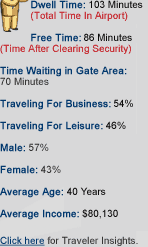


 ARNSmokers and Non-Smokers can Coexist with Proper VentilationThe urge to smoke in airports seems to have been stoked by the generally heightened tension in airports, according to Ira Weinstein president of Airport Interviewing & Research (AIR), which has conducted studies on the subject. While it is difficult to quantify, participants in focus groups say they are smoking more not necessarily because of additional dwell time but because they are more nervous in airports these days, he says. However, in many airports smoking is prohibited completely or confined to smoking rooms and food/bar facilities. In a few instances, state legislatures have banned smoking in public places throughout the entire state (see smoking policy chart). But in airports that permit it, creating comfortable areas to smoke without impinging on the air quality of non-smokers, is considered an important customer service issue. "Our studies have shown, even before 9-11, that passengers want to have places to smoke in the airport and not in just glass-walled pens where everyone can see how bad the ventilation system is," says Weinstein.
|
|||||||||||||||||||||||||||||||||||||||||||||||||||
|
||||||||||||||||||||||||||||||||||||||||
HMSHost’s new Auto Raceway concept at Las Vegas (LAS) is a refurbished food & beverage facility that was, at one time, an open-enclosed air space overlooking the airport’s esplanade area. The company enclosed it with walls and doors and re-engineered the HVAC system to create a flow that draws in air from the public area than evacuates it to the outside. Novack says the new system uses quiet, state-of-the art technology and has been very effective in eradicating smoky air, a feature earlier systems could not claim. "We have found that there is no smoke drift outside the facility and the customer reaction has been very positive; you can’t smell or see it," says Novack.
In another facility at LAS that is not ventilated, HMSHost surveyed customers about the air quality and found that the air was perceived as being very smoky. "It’s a question of air quality. Smokers don’t like a smoke-fill room either. If there is a perception from the customer that the air quality is better, I think it makes them stay longer because overall it is a better experience." The company is converting several of its other facilities in Concourses A and B and will be installing the same type of ventilation system.
The cost to install the systems can range from $10,000 to $50,000 depending on several variables including what system exists now, the size of the space, air movement, the goals of the concessionaire, etc. "There is no magic bullet because there are a lot of questions that have to be resolved. You basically have to work out a ventilation plan based on the specifics of each existing site," says Novack.
Planning for a Ventilation System
One company that facilitates the process from planning to installation is Phillip Morris through its Options program. It is clearly in the best interests of the tobacco company to make everyone comfortable with air quality where there are smokers and the program is designed to do just that: help business owners and hospitality venues sort out their individual circumstances and assist them in setting up a ventilation system that is best suited to their needs.
"The Options initiative is not about addressing the health affects of second hand smoke." The goal of the program is to help operators do everything they can to minimize second hand smoke. "We’re being proactive about addressing the issue of air quality and that is why Options is available to everyone in the hospitality industry," says Billy Abshaw, manager media programs, Phillip Morris USA.
In select cases, Options’ free service will refer an assessment engineer who will analyze the existing facility and determine which systems might work best to improve the indoor air quality of that particular restaurant or bar. Options does not endorse specific manufacturers of the technology or installers of the equipment but acts as a referral service for the client as well as serves as an information bank on the different possibilities. Options also offers a free hotline service interested parties can call to talk to an indoor air quality expert. For more information about the Options initiative click on www.PMOPTIONS.com.
"The concession operator or airport provides blueprints to the engineer who goes out to the facility and physically looks at the air flows, takes measurements of what is existing, or if it is a new facility will assess the new space," says Abshaw. "Based on that information a written assessment is issued to the client and two or three choices are provided with cost estimates. Then it is up to the concessionaire or airport to choose the option and implement the plan."
Novack of HMS Host says it has used the Options service for a few of its airport facilities and has been pleased with the support it received. At Pittsburgh, BAA USA worked through the Options program to find the right system for three restaurant/bars in the airport: The Original Oyster House, Fat Tuesdays, and Sam Adams Brewhouse.
The issue arose when BAA received several complaints about smoke in the eating facilities, according to Cathy Simoni, retail operations executive for BAA. An assessment was made and an exhaust system was chosen where an air curtain that forms at the front of the building forces the smoky air out through a ventilation duct. Fresh air is then pulled back into the facility. The system runs 24-hours a day providing constant fresh air, but a timed regulator triggers the system to use more or less energy depending on the expected traffic levels, which ensures productive energy usage.
"We were looking for a way that did not recycle the air and we wanted to keep the smoke out of the concourse to service both smokers and non-smokers," says Simoni. "This system takes it right out and the only real expense was cutting a hole in the roof. Systems that recycle air are a little cheaper but in the long run, you have to replace them or change filters and it becomes a non-winning situation."
A new ventilation system was recently installed in the Original Oyster House, operated by Joll Enterprises Inc. The system works with an already installed HVAC system so it was able to be put in from scratch, according to Mark Pierce, vice president of, the operator of the Original Oyster House." In the old days you had to have two separate systems and they were very noisy; they used to sound like a jet was landing. This system is noiseless and very effective."
Simoni says the installation of new ventilation is not yet a requirement for all food tenants at PIT, but going forward as restaurants are remodeled and contracts are redrawn, BAA will definitely look at that possibility.
Another obstacle for smokers in the new environment of airports is the difficulty of exiting a secure area for the purpose of a smoke, then having to go back through a long security line. "If your airport is one that permits smoking it may be important to have places before and after security so people don’t have to go back through the security checkpoint," says Abshaw of Options.
"I think a lot of airports are realizing now that there are fewer non-smoking airports. Our goal is to make sure both smokers and non-smokers are comfortable, whether in common areas, bars, or lounges; it’s a matter of comfort for both.
 |
||
 |
 Major
U.S. Airport Smoking Policies as of December 2001
Major
U.S. Airport Smoking Policies as of December 2001